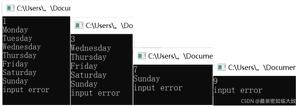在C ++中删除间隔
假设我们有一个不相交间隔的排序列表,每个间隔interval [i] = [a,b]代表一组数字x,使得a <= x <b。我们必须删除区间中的任何区间与toBeRemoved区间之间的交点。最后,我们必须在所有此类删除之后找到间隔的排序列表。因此,如果输入类似于− [[0,2],[3,4],[5,7]]和toBeRemoved:= [1,6],那么输出将为[[0,2],[ 6,7]]。
为了解决这个问题,我们将遵循以下步骤-
定义一个称为handler2()的方法,它将采用矩阵a和数组y
x:=矩阵a的最后一行,然后从a删除最后一行
z:= x
x [0]:= y [1],z [1]:= y [0]
如果z [0]-z [1],则将z插入
如果x [0]-x [1],则将x插入
主要方法将采用矩阵in和数组t
定义一个矩阵ans,并且n:=矩阵中的行数
因为我的范围是0到n –
将[i]插入ans
a:= a的最后一行,b:= t
如果a [0]> b [0],则交换a和b
如果a和b相交,则调用操纵2(ans,t)
返回ans
例子(C ++)
让我们看下面的实现以更好地理解-
#include <bits/stdc++.h>using namespace std;
void print_vector(vector<vector<auto> > v){
cout << "[";
for(int i = 0; i<v.size(); i++){
cout << "[";
for(int j = 0; j <v[i].size(); j++){
cout << v[i][j] << ", ";
}
cout << "],";
}
cout << "]"<<endl;
}
class Solution {
public:
bool isIntersect(vector <int> a, vector <int> b){
return max(a[0], a[1]) >= min(b[0], b[1]);
}
void manipulate2(vector < vector <int> > &a, vector <int> y){
vector <int> x = a.back();
a.pop_back();
vector <int> z = x;
x[0] = y[1];
z[1] = y[0];
if(z[0] < z[1])a.push_back(z);
if(x[0] < x[1])a.push_back(x);
}
vector<vector<int>> removeInterval(vector<vector<int>>& in, vector<int>& t) {
vector < vector <int> > ans;
int n = in.size();
for(int i = 0; i < n; i++){
ans.push_back(in[i]);
vector <int> a;
vector <int> b;
a = ans.back();
b = t;
if(a[0]>b[0])swap(a, b);
if(isIntersect(a, b)){
manipulate2(ans, t);
}
}
return ans;
}
};
main(){
vector<int> v2 = {1,6};
vector<vector<int>> v1 = {{0,2},{3,4},{5,7}};
Solution ob;
print_vector(ob.removeInterval(v1, v2));
}
输入值
[[0,2],[3,4],[5,7]][1,6]
输出结果
[[0, 1, ],[6, 7, ],]
以上是 在C ++中删除间隔 的全部内容, 来源链接: utcz.com/z/316244.html







